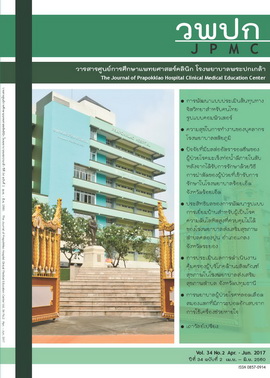การพยาบาลผู้ป่วยโรคหลอดเลือดสมองแตกที่มีภาวะปอดอักเสบจากการใช้เครื่องช่วยหายใจ
Main Article Content
Abstract
ที่มาของปัญหา : ผู้ป่วยโรคหลอดเลือดสมองแตกที่มีภาวะปอดอักเสบจากการใช้เครื่องช่วยหายใจมีความเสี่ยง ต่อการเสียชีวิต มีจำนวนวันนอนและค่าใช้จ่ายในการดูแลรักษาเพิ่มขึ้น พยาบาลต้องมีความรู้ความสามารถใน การประเมินระยะแรกเพื่อการดูแลและรักษาให้ทันเวลา เพื่อป้องกันการเกิดภาวะแทรกซ้อนที่อาจเกิดขึ้นได้
วัตถุประสงค์: เพื่อศึกษาเปรียบเทียบการพยาบาล ผู้ป่วยโรคหลอดเลือดสมองแตกที่มีภาวะปอดอักเสบจากการใช้เครื่องช่วยหายใจ
รูปแบบการศึกษา: งานวิจัยเชิงกรณีศึกษาเพื่อเปรียบเทียบ (comparative case study) ผู้ป่วยโรคหลอดเลือดสมองแตกที่มีภาวะปอดอักเสบจากการใช้เครื่องช่วยหายใจ จำนวน 2 ราย รวบรวมข้อมูลระหว่าง วันที่ 3 เดือนสิงหาคม พ.ศ. 2558 - วันที่ 1 เดือนเมษายน พ.ศ. 2559 โดยใช้แบบบันทึกข้อมูล แบบสัมภาษณ์และแบบบันทึกการสังเกต รวบรวมและวิเคราะห์ข้อมูล
ผลการศึกษา: ผู้ป่วยรายที่ 1 หญิงไทยอายุ 43 ปี โรคประจำตัวคือโรคความดันโลหิตสูง มาโรงพยาบาลด้วยอาการไม่รู้สึกตัว เอ็กซเรย์คอมพิวเตอร์สมองพบก้อนเลือดในสมองบริเวณเบซัลแกงเกลียด้านซ้าย ได้รับการผ่าตัดสมองแบบปิดกะโหลกศีรษะ ผู้ป่วยรายที่ 2 ชายไทยอายุ 59 ปี โรคประจำตัวคือโรคความดันโลหิตสูง ตับอักเสบและโรคหลอดเลือดสมองแตกเดิม มาโรงพยาบาลด้วยอาการไม่รู้สึกตัว เอ็กซเรย์คอมพิวเตอร์สมองพบก้อนเลือดในสมองบริเวณเบซัลแกงเกลียด้านขวา และเข้าไปในโพรงสมองร่วมกับมีภาวะสมองบวมได้รับการผ่าตัดสมองแบบไม่ปิดกะโหลกศีรษะ ผู้ป่วยทั้ง 2 รายมีความแตกต่างที่พยาธิสภาพความรุนแรงของโรคเลือดออกในสมอง มีความเหมือนกันคือประวัติโรคความดันโลหิตสูงและการดื่มแอลกอฮอล์ ผู้ป่วยทั้ง 2 รายเกิดภาวะแทรกซ้อนคือ ภาวะปอดอักเสบจากการใช้เครื่องช่วยหายใจ แต่พบในผู้ป่วยรายที่ 2 เร็วกว่าผู้ป่วยรายแรก มีสาเหตุการติดเชื้อมาจากการสูดสำลักและมีภาวะแทรกซ้อนหลายปัญหา ได้แก่ เลือดออกในทางเดินอาหารส่วนต้น ปัจจัยการแข็งตัวของเลือดผิดปกติ ภาวะไม่สมดุลของเกลือแร่ ส่งผลกระทบต่อการฟื้นตัวของผู้ป่วย ทำให้จำนวนวันนอน (30 วัน) นานกว่าผู้ป่วยรายแรก (19 วัน)
สรุป: การศึกษาครั้งนี้แสดงให้เห็นว่าพยาบาลเป็นผู้ที่มีบทบาทสำคัญ ในการประเมินและค้นหาปัญหา ผู้ป่วยตั้งแต่แรกรับ การเฝ้าระวังอาการเปลี่ยนแปลงทางระบบประสาทและการป้องกันภาวะปอดอักเสบจากการใช้เครื่องช่วยหายใจ ส่งผลให้ผู้ป่วยได้รับการรักษาพยาบาลที่รวดเร็วทันเวลา เพื่อให้ผู้ป่วยปลอดภัย นอกจากนี้ยังส่งเสริมให้ญาติมีความรู้ในเรื่องปัจจัยเสี่ยงที่ควบคุมได้ของการเกิดโรคหลอดเลือดสมองแตก ได้แก่ ภาวะความดันโลหิตสูง การสูบบุหรี่และการดื่มแอลกอฮอล์ นำไปปฏิบัติเพื่อป้องกันการเกิดโรคหลอดเลือดสมองแตกต่อไป
Background: Hemorrhagic stroke patients with ventilator associated pneumonia have increased risk for mortality. Length of stay and cost of care were increasing. Nurse should have knowledge and ability to early assess in order to receive cure and care on time to prevent complication may occur.
Objectives: To comparison of the nursing care between 2 cases of hemorrhagic stroke patient with ventilator associated pneumonia.
Material and Methods: The comparative case study of 2 cases of hemorrhagic stroke patient with ventilator associated pneumonia. The data were collected between August, 3 2015 and April, 1 2016. Data collection sheet, interview guide and observation note forms were used to collect the data. Content analysis was used to interpret the data.
Results: The first patient was a 43 years old woman with a history of hypertension, coming to the hospital with coma. Computer scans of the brain found blood clot in the brain at left basal ganglia and underwent left craniotomy. The second patient was a 59 years old man with a history of hypertension, hepatitis and previous hemorrhagic stroke, coming to the hospital with coma as well. Computer scans of the brain found blood clot in the brain at right basal ganglia, entering the brain canal and brain edema and underwent right craniectomy. Both patients have differences in the severity of pathology of intracerebral hemorrhage and have similar in the history of hypertension and alcohol drinking. Both patients have ventilator associated pneumonia which is occur in the second patient earlier than the first patient. The cause of infection in the second patient was aspiration and has many complications such as upper gastrointestinal bleeding, coagulopathy and electrolyte imbalance that affected to the recovery of the patient and the length of stay (30 days) longer than the first patient (19 days)
Conclusion: This study reveals that nurse plays a crucial role in assessment of the problem from the first day of visit, aware of a suspected change in neurologic function and prevention of ventilator associated pneumonia. These can help patient to receive prompt nursing care and safety. Moreover, promoting the knowledge of caregiver in modifiable risk factors of hemorrhagic stroke such as hypertension, smoking, and drinking in order to promote the practice of prevention for hemorrhagic stroke.
